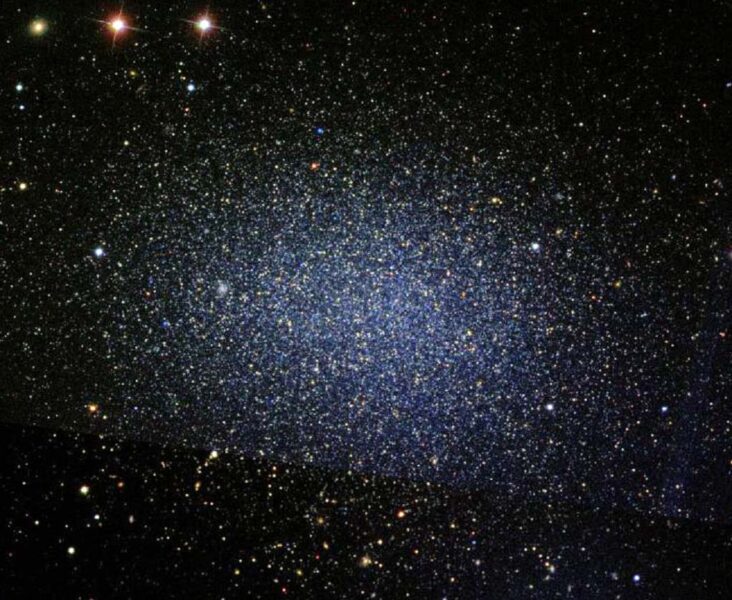
SDSS
All black holes are mysterious, but this one defies explanation.
At the center of Leo I, a dwarf galaxy about 100,000 times less massive than our own, astronomers have discovered a black hole nearly as big as the behemoth at the core of the Milky Way. No one knows where it came from or how it got there. Like finding the wreck of the Titanic at the bottom of a pond, the scales simply don’t match up.
“My first reaction was total disbelief,” recalls María José Bustamante-Rosell (now at University of California, Santa Cruz), who led the study published in The Astrophysical Journal. Her team examined the integrated light of stars in Leo I to measure how their typical speeds varied throughout the galaxy. In doing so, they noticed extreme motions around the center — telltale sign of the strong, concentrated gravitational pull of a black hole. By their estimate, the core of Leo I weighs in at around 3 million times the mass of the Sun (though that value could range from 1.3 million to 5.3 million solar masses).
“I don’t think anyone expected this,” says Mark den Brok (Leibniz Institute for Astrophysics Potsdam), who was not involved in thes tudy. The discovery of a huge black hole in “such a wimpy galaxy,” he remarks, “is really surprising.”
Wimpy is a good way to describe it. Leo I is a dwarf spheroidal galaxy, meaning it is a small but massive group of stars. Though dwarf spheroidals are probably very common, they are so dim that astronomers have discovered only a few.
There are two known ways to end up with a supermassive black hole in a small galaxy: start with a huge galaxy and rip away most of the stars, or start with many small galaxies and combine them together. The first option would not leave enough of the galaxy behind, while the alternative, piece-by-piece growth, has never been known to make anything like Leo I.
There are caveats. “Leo I could very well be a weird one-off,” Bustamante-Rosell explains. Astronomers will have to look for more black holes in dwarf spheroidals to be certain something pathological is going on. If it is, then a crucial piece is missing from what we know about how black holes are born or how galaxies form — or maybe even both.
As den Brok puts it: “This might lead to a paradigm change.”
 6
6









Comments
AlexRosefur
December 9, 2021 at 3:17 pm
It's as you said, it's a wimpy galaxy with a small but massive group of stars and what do massive stars make? Massive black holes.
You must be logged in to post a comment.
StanR
December 11, 2021 at 10:08 pm
However, massive star black holes are orders of magnitude smaller than center-of-galaxy black holes.
You must be logged in to post a comment.
Rich
December 14, 2021 at 12:01 am
Hello,
I'm guessing that the image with the inset of Leo I is from the ApJ paper and not from S&T.
The image is weird because it is the Gaia Early Data Release 3 map of the night sky and it is presented as being the Milky Way. And it looks like they are trying to show the position of Leo I outside of the Milky Way.
You must be logged in to post a comment.
Monica Young
December 14, 2021 at 2:05 pm
Hi Rich, the image comes from the press release (https://mcdonaldobservatory.org/news/releases/20211201). Yes, it's a Gaia map of the night sky, and most of the stars Gaia's observing are in the Milky Way. Leo I is a dwarf galaxy outside the Milky Way — it's a satellite of our galaxy.
You must be logged in to post a comment.
Rich
December 14, 2021 at 7:01 pm
Hi Monica,
I have just found the utexas news which had the link which you gave and then I came back here. The link you gave also has the arXiv link to the ApJ paper. The paper seems like it is an example of Good Ole Basic Science (tm). 🙂
The press release use of the night sky all-sky to represent the Milky Way just sticks in my craw; it's just not the same. I probably should sleep on it before I contact U of Texas. 🙂
You must be logged in to post a comment.
Monica Young
December 19, 2021 at 3:03 pm
Upon further reflection, I've replaced the lead image with the image of just Leo I. 🙂
You must be logged in to post a comment.
You must be logged in to post a comment.